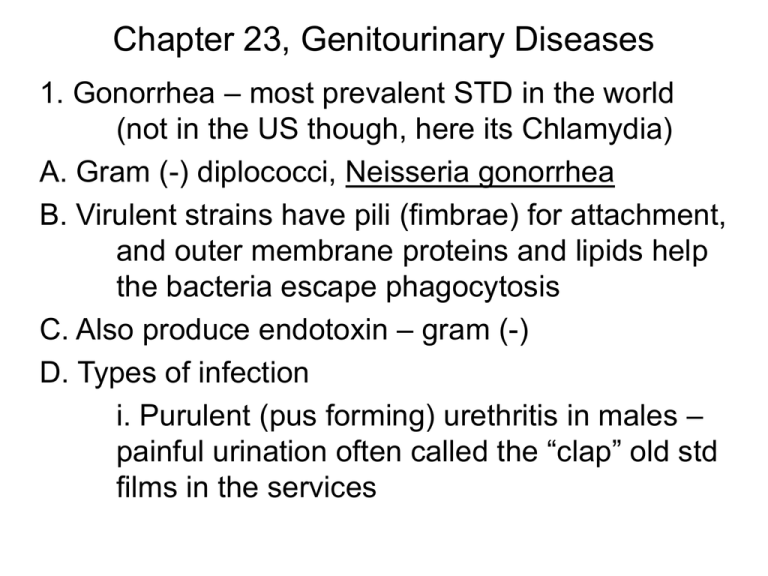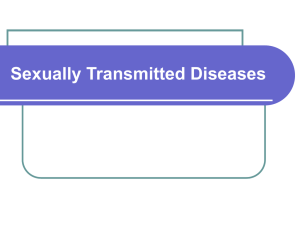Chapter 23, Genitourinary Diseases
advertisement

Chapter 23, Genitourinary Diseases 1. Gonorrhea – most prevalent STD in the world (not in the US though, here its Chlamydia) A. Gram (-) diplococci, Neisseria gonorrhea B. Virulent strains have pili (fimbrae) for attachment, and outer membrane proteins and lipids help the bacteria escape phagocytosis C. Also produce endotoxin – gram (-) D. Types of infection i. Purulent (pus forming) urethritis in males – painful urination often called the “clap” old std films in the services Chapter 23, Genitourinary Diseases 1. 2 –3 days after exposure, 80% show symptoms 2. Before antibiotics, some serious problems, scarring and blockage of urethra or testicular infection, sterility results from blockage of vas deferens ii. Often asymptomatic in females – only the cervix is infected 1. Common cause of “PID” pelvic inflammatory disease, Chlamydia is often also associated with gonorrheal PID 2. Serious problem in untreated cases later on – PID , other infection complications and sterility 3. Rare cases, systemic and then can cause gonorrheal arthritis, gonorrheal endocarditis, even meningitis Fig. 23.8 Chapter 23, Genitourinary Diseases E. Prevention and treatment iii. Infants can acquire during birth, neonatal gonorrhea 1. Can cause blindness 2. All babies eyes are treated with antibiotics at birth iv. Anal and pharyngeal gonorrhea are also quite common Chapter 23, Genitourinary Diseases E. Prevention and treatment i. Good diagnostic test, genetic probe ii. No good antibody response and no lasting immunity iii. Drug resistance is a problem, usually treated with now with ceftriaxone – a type of cephalosporin iv. Since Chlamydia is often also associated with gonorrhea – antibiotics for it are also administered (tetracycline) v. Prevention: sex education, condoms vi. Drug resistance, beta lactamase oriented in GC infections vii. Also lipid coat changes rapidly and may be reason the antibody produced is not effective Chapter 23, Genitourinary Diseases viii. Culture of GC is tough – special media required, but culturing is helpful in determining antibiotic sensitivity (nutritional fastidious bacteria – survive poorly outside of the body – so much for the “I got it off the toilet seat or in the swimming pool” Fig. 23.9 Neonatal gonococcal opthalmia Fig. 23.10 Chapter 23, Genitourinary Diseases 2. Syphilis – causative agent – Treponema pallidum, a spirochete, gram negative, appears as a tightly coiled helix, very difficult to culture (only cell cultures) A. STD, disease progresses through discernable stages B. Primary Syphilis i. 2-6 weeks after exposure, small hard chancre (sore) at site of exposure, painless, fluid excreted is highly contagious, easier to id chancre in males, often missed in females Chapter 23, Genitourinary Diseases ii. Darkfield microscopy of lesion exudate shows many spirochetes iii. The microbe enters blood stream and lymphatic system and is disseminated throughout the body iv. RPR test, non-treponemal diagnosis test, tests for “reagin” – an antigenic response test (inflammatory) reaction C. Secondary Syphilis – several weeks later, skin rash can occur, lymph nodes swell, sometimes fever. Patient will still test positive for RPR test and sometimes even spirochetes (these lesions can be highly contagious) Chapter 23, Genitourinary Diseases i. Symptoms subside after a few weeks ii. Latent phase occurs, if untreated can last for years, in about 50% of the cases, that is the end of it iii. But can progress to tertiary stage D. Tertiary syphilis – many years later (30?), organisms lies dormant in tissues of the body i. Infective in early latent period and will test positive for syphilis ii. Old fluorescent Ab test (now use quick test kits) would be positive early in the latent period (note: like gonorrhea, syphilis can be acquired over and over again – the Ab are not effective) Chapter 23, Genitourinary Diseases iii. Disease is activated, serious damage to heart, brain – can lead to dementia, seizures, and blindness iv. Skin lesion and lesions in organs are gross looking (gummas) – see page 750 v. Congenital syphilis – spirochete crosses placental barrier and fetus is harmed, birth defects (one reason for detection and treatment) E. Treatment is with penicllins. Sex education and condom use is also important Fig. 23.15 Gumma on patients arm Fig. 23.14 Secondary syphilis rash Fig. 23.16 Congenital syphilis. Pg 751 Fig. 23.17 Fig. 23.18 Spirochete - darkfield Chapter 23, Genitourinary Diseases 3. Chlamydia – small gram(-) obligate intracellular parasite, C. trachomatis, the most prevalent STD in US, cause of NGU (non gonococcal urethritis) A. Mild disease, not as serious as gonorrhea or syphilis B. Urethritis or vaginits and can cause PID (lead to sterility) C. Since symptoms are so mild often goes untreated D. Can cause blindness in infants, reason for treating babies eyes as they are born E. Actual leading cause of blindness in developing countries, a different strain? Spread on contact with secretions, flies, fomites F. Rapid tests now available G. Treat with doxycycline or erythromycin Fig. 23.12 Chlamydia on mucosa of fallopian tube Chapter 23, Genitourinary Diseases 4. Herpes – causative agent is herpes simplex ii virus, DNA virus, transmitted by sexual contact A. Incubation period about a week, then burning sensation at the site of infection followed by eruption of lesions (vesicles) B. Painful and irritating, but problem is that the disease can reoccur and can be a problem for life – life long latent state in the peripheral nerves C. Neonatal herpes – serious complication – cause for C section delivery D. Virus can cross placental barrier and cause spontaneous abortion, birth defects, and retardation E. No cure, some management of symptoms with drugs like acyclovir and some newerones) Fig. 23.19 Neonatal Herpes simplex Fig. 23.21 Electron photo of herpes Chapter 23, Genitourinary Diseases 5. HPV – human papilloma virus, can causes genital warts, also linked to cervical cancer. Controversial vaccine for hpv 6. E. coli – causes UTI infections – usually normal flora, treat with sulfonamides and trimethoprim together 7. Gardnerella - G. vaginalis – causes foul smelling vaginal infection, often associated with other pathogens – polymicrobial infection, diagnosed by symptoms and treated with broad spectrum antibiotics Chapter 23, Genitourinary Diseases HPV vaccine Chapter 23, Genitourinary Diseases 8. Candida infections – yeast can infect when there is a ph imbalance (due to broad spectrum antibiotic treatment for other diseases) 9. Trichomonas –T. vaginalis – flagellate protozoan, causes painful infection of urethra or vagina, copious discharge - treat with metronidazole 10. Group b Strep – bacterial inhabitants of vaginal tract can infect newborn if fetal membranes are broken – causes pneumonia and septicemia even meningitis in newborn Chapter 23, Genitourinary Diseases Chapter 23, Genitourinary Diseases Group b Strep in newborn Chapter 23, Genitourinary Diseases 11. Cytomegalovirus – (CMV) DNA virus in the herpes family, very common virus transmitted by close contact or sexually, mild disease but can cross placental barrier and cause fetal death or birth defects – infected cells fuse to form giant cells – great big cells


